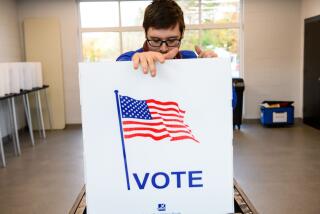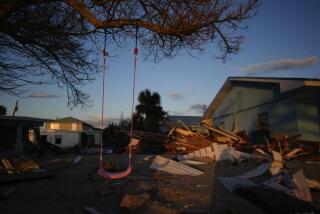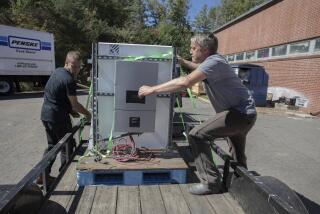This Caribbean Storm Left a Legacy of Growth : U.S. Virgin Islands: A year after Hurricane Hugo’s destruction, many tourist facilities have been renovated to better-than-original condition.
It all happened one year ago Monday: Sept. 17, 1989.
Hurricane Hugo smashed into the U.S. Virgin Islands, bringing with it 200-m.p.h. winds and monsoon rains. It was the worst storm to hit the islands in 61 years. And the devastation was massive.
Hundreds of homes and condominiums were destroyed, windows broken, roofs blown away. Thousands of trees were uprooted and killed. Power and phone lines were cut.
And there was similar major damage to dozens of hotels and resorts. Some were destroyed. Miraculously, there were few injuries or fatalities.
Of the 50 islands, islets and cays that make up the U.S. Virgin Islands, the hardest hit was St. Croix. It suffered the worst damage--first by the hurricane, and then by two days of looting and vandalism.
When it was all over, the U.S. Virgin Islands was facing a crisis. Tourism is by far the territory’s major industry. Nearly 2 million visitors--mostly hotel guests and cruise passengers--visit the islands each year, spending more than $750 million.
Hurricane Hugo changed all that, and tourism officials, airlines, hotel and resort operators were all anticipating the loss of an entire tourism season, possibly two seasons.
Hotels and resorts suffered $105 million in physical damage. Of 1,800 rooms on St. Croix, just 270 were thought to be usable after the storm. And the island’s primary cruise dock at Frederiksted was wiped out.
Already that year, tourism had been slow, due in part to the Eastern Airlines strike. And Hugo threatened to halt visitor arrivals altogether.
To be sure, government officials knew they had to literally rebuild parts of the islands. But they also had to rebuild an image that would once again be attractive to tourists.
Immediately after, hurricane assistance poured in from many sources. The U.S. Department of Agriculture provided more than 4.2 million pounds of food. The U.S. Army Corps of Engineers repaired water-supply systems and distributed 100,000 gallons of water each day.
Air carriers pitched in. American Airlines waived all advance-purchase restrictions and offered $99 fares for anyone returning to St. Croix to help in the rebuilding. Pan Am matched the fares. And in many cases, the airlines unofficially waived excess baggage charges.
Most cruise lines canceled their St. Croix itineraries. One cruise ship, the Sun Viking, docked briefly at St. Thomas and donated badly needed food supplies. Virtually every federal agency was involved in the relief effort, which in its first six months generated more than $580 million to help rebuild the islands.
To date, more than $1.6 billion has been pumped into the Virgin Islands economy after Hugo.
Actually, St. Croix did have a big season last winter and spring. The hotels were full. It was tough to get a reservation at a good restaurant.
But none of the guests were vacationers. Instead, the rooms were filled with insurance agents, claims adjusters, carpenters and contractors.
But what about tourists? As the high season of 1990-91 draws to a close, are the islands ready? Is it time to go back?
At first glance, the answer would seem to be no. Passengers deplaning at St. Croix’s Alexander Hamilton Airport are confronted with the mangled roofs of nearby buildings. A few airplanes, broken in two by Hugo, sit stacked next to a perimeter fence near the road leading from the airport.
Many corrugated roofs are rolled back, twisted and crumpled. Old telephone poles lean precariously, and much of the 2.1 million cubic yards of Hugo debris still awaits disposal.
But looks can be deceiving.
Most St. Croix hotels and St. Thomas properties have been rebuilt, and should be open by Oct. 15.
“We didn’t have first-time guests come here after the hurricane,” says Elizabeth Armstrong, whose family runs the Buccaneer Hotel, which suffered $2 million in damages. “But a lot of our regular guests are starting to come back now.”
Still, there are hotels that won’t be coming back, or at the very least not coming back soon. On St. Croix, the Divi St. Croix Beach Resort, Queen’s Quarter Hotel, Tamarind Reef and Grapetree Bay Hotel were virtually destroyed. Some hotels, like the Tamarind Reef, were simply abandoned.
“These hotels were either under-insured, or their insurance companies went bankrupt,” says Arlene Stevens, an official for the Virgin Islands division of tourism. “Or, in some cases, the owners decided it was just too much work to try and start over again.”
Stevens lost her condominium in the storm, and it has yet to be rebuilt. And she’s not alone. Many of the locals still haven’t moved back home.
“The emphasis,” says Leona Bryant, director of tourism for the U.S. Virgin Islands, “has been on rebuilding the tourism infrastructure first.”
Indeed, Bryant is also not yet back in her home. “One of the efforts we’ve made since the hurricane,” said Bryant, “is to make the island more affordable and attractive for the people who live here--as well as for the vacationer.”
“I suppose the hurricane did us a favor,” said Stevens. “It gave everyone the opportunity to finally go in and do some much-needed renovation.”
“At first, I thought Hugo did us in,” said Cormorant Beach Club General Manager Lawrence Bathon. “We lost the beach, and there was extensive wind and water damage to the buildings.”
Helped by insurance money, Bathon embarked on an ambitious rebuilding program. First, he barged in 5,000 yards of sand from Barbuda. And then he started replanting some of the trees.
Before Hugo, the hotel boasted 330 trees on the property. But 250 were destroyed by the hurricane. “We like to say our beach is sunnier now,” said Bathon with a laugh. “I hope that won’t become our slogan.”
“It was more than an opportunity to make money,” said Ted Ziegler, president of Caribbean Construction Services in St. Croix. “It gave all of us an opportunity to discover each other, to talk and share our experiences. It brought us all closer. And, considering the damage, I’m surprised we have recovered as much as we have.”
Thanks to the hurricane, St. Croix now has a new power plant (brownouts and blackouts are virtually nonexistent) and a new cellular telephone system.
“It accelerated our renovation program,” says S. Lee Bowden, vice president and general manager of St. Croix’s largest hotel, the 150-room Carambola Beach Resort & Golf Club. The hotel, helped by a $17-million insurance payment, spent $19 million in renovations.
In Frederiksted, the government has rebuilt the pier, but not in time to attract enough cruise ships this year. Many of the shops there were damaged and have yet to reopen.
“It’s like the chicken and the egg,” says Eric Dawson, U.S. Virgin Islands commissioner of economic development. “The cruise lines say if the shops open, we’ll come back. We say if the ships come, the shops will reopen. It will just take time.”
As for air traffic, by Nov. 1 American Airlines will have four flights a day to St. Croix, down from six last year. Eastern will have three daily flights, up from two. And Continental now flies to the island from Newark, N.J.
Meanwhile the Virgin Islands has initiated a major advertising and promotional campaign. “We have to fight the image that we are destroyed,” said Dawson, who convinced many hotels in St. Croix to offer a “5 will get you 7” discount promotion. Through Dec. 15, if you stay seven nights at most hotels, you only pay for five.
And in St. Thomas, there’s another reason to visit now, and it has nothing to do with Hugo. The government reports that more than 87 permits have been issued to build new hotels, resorts and condominiums on the island.
Later this week, a number of hotels and resorts on both St. Thomas and St. Croix are hosting “Hugo’s Over” parties, celebrations to mark the anniversary--not of the hurricane but of the spirit of cooperation that the hurricane created among the people of the islands.
In attendance will be a number of 3-month-old “Hugo babies,” children who were conceived during--or immediately after--the storm, when there was no power on the islands . . . but presumably a lot of energy.
RELATED STORY: L3
More to Read
Sign up for The Wild
We’ll help you find the best places to hike, bike and run, as well as the perfect silent spots for meditation and yoga.
You may occasionally receive promotional content from the Los Angeles Times.






